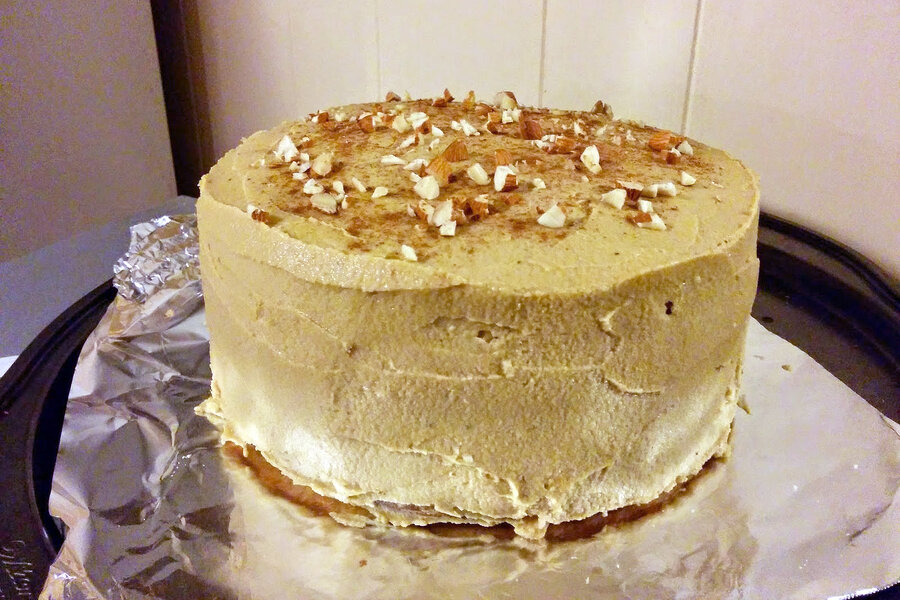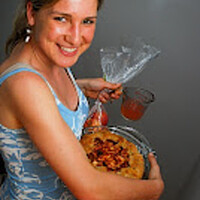Sweet potato cake with molasses buttercream
As of about a week ago a shockingly beautiful and balmy autumn came to an abrupt end, and we are currently in the midst of a nor'easter, as the New Englanders say. The wind is blowing, the rain is falling, and my bike ride to and from school (and everywhere else I go) has become decidedly damply disagreeable.
We are also in the midst of our own personal nor'easter here at the Fletcher School. By that I mean, we're mid-semester and gusts of oh-jeez-it's-time-to-start-that are howling, the constant drip-drop of doodle polls (to schedule all the group meetings) are dampening our mood, and every now and then a torrent of class to meeting, to study group, to job application, to class, to office hours pours on our heads, soaking our spirits and squelching our self-confidence.
But just like how in a real storm people are nicer, in this storm of work we are lucky to have each other! Friends tutor friends, hugs and high-fives are the norm, and every time someone says I don't think I'm going to make it, someone else says Yes you will!
This week was particularly bad for a few of my friends. There were some big scary mid-terms going on and by Wednesday afternoon everyone looked a mix of dazed and relieved and tired. So what did we do? Celebrate of course. And what did I bring? Cake, well duh.
This recipe is all things fall – slow roasted, super-sweet sweet potatoes; spicy spices; and a molasses buttercream that I thought might be too much, but is really just right. The cake itself is very light, thanks to the beaten egg whites, and really does taste like sweet potatoes, not like wannabe pumpkin. And the frosting. Oh the frosting. I love molasses, so obviously this was great.
Sweet potato layer cake with molasses buttercream
Adapted from Love and Olive Oil
For cake
1 large sweet potatoes (about 1/2 lb)
3 cups cake flour
3 teaspoons baking powder
1-/2 teaspoons cinnamon
3/4 teaspoon grated nutmeg
1/4 teaspoon ground cloves
1/2 teaspoon salt
5 eggs, separated
2 1/4 cups granulated sugar, divided
1 stick unsalted butter, room temperature
1-1/2 teaspoons vanilla
1 1/4 cups milk
For frosting
1-1/2 cups (3 sticks) butter, room temperature
4 cups powdered sugar
1/4 cup molasses
1/4 cup milk or cream, more or less as needed
1. Preheat oven to 400 degrees F. Prick sweet potato in a few spots with a fork, then place on a foil-lined baking sheet and bake for about 1 hour, or until the potato is very soft and beginning to caramelize. Remove from oven and cool slightly.
2. Reduce the oven temperature to 350 degrees F. Butter the bottoms and sides of three 9-inch round cake pans. Line with parchment paper or a square of foil; butter and flour parchment/foil.
3. When the sweet potatoes are cool enough to handle, peel of the skins and remove any blemishes. Pulse in a food processor until smooth. Measure out 1 cup of puree (discard or reserve the rest for another use).
4. In a bowl, sift together flour, baking powder, cinnamon, nutmeg, cloves, and salt. Set aside.
5. In a large metal mixing bowl or the bowl of a stand mixer fitted with the whisk attachment, beat egg whites on medium speed until frothy. Gradually beat in 1/4 cup of sugar, increase speed to high, and beat until the egg whites form moderately stiff peaks.
6. In another large mixing bowl, combine sweet potato, butter, vanilla, and remaining 2 cups sugar. Beat on medium-high speed until light and fluffy, about 2-3 minutes. Add the egg yolks, one at a time, mixing well after each addition. With the mixer on low speed, add 1/3 of the dry ingredients, followed by 1/2 of the milk. Repeat with another 1/3 dry ingredients, remaining milk, and finally remaining dry ingredients, mixing until just incorporated.
7. Using a large rubber spatula, fold 1/4 of egg whites into the batter to lighten it. Add the remaining egg white and continue to fold just until incorporated; be sure not to over-mix the batter.
8. Divide batter among prepared cake pans and bake for 25 to 30 minutes or until a toothpick inserted near the center comes out clean. Let cool for 10 minutes, then turn out onto wire racks and cool completely, at least 1 hour.
9. For the frosting: In a large mixing bowl, beat butter on medium-high speed until smooth and fluffy, 2-3 minutes. Add powdered sugar, 1/2 cup at a time, mixing well after each addition. Add molasses and beat until incorporated. Depending on the temperature and consistency of your frosting at this point, add milk or cream, 1 Tablespoon at a time as needed, then continue beating until frosting is light and fluffy.
10. Assembly: Place one layer, flat side down, on a cake stand or serving platter. Spread on a layer of buttercream. Position second layer on top. Repeat with another layer of buttercream, and then position final cake layer, flat side up.
11. Cover the entire cake with a thin layer of buttercream. This "crumb coat" will make frosting the cake easier. Refrigerate for about 15 minutes to allow this crumb coat to set.
12. Remove cake from refrigerator and frost with remaining buttercream. I garnished the top with chopped almonds and cinnamon, just because.
Related post on Eat. Run. Read: Apple Oatmeal Muffins







